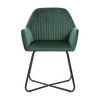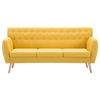Quality measuring tools for unmatched accuracy
Gone are the days of speculation when using measuring objects. No more staring at the ruler or hoping the tape measure won’t fall off in the wash. Welcome to the realm of precision in which materials meet their match: measuring tools. From the standard ruler to the laser gauges, vidaXL has a tool for every corner, curve, and cranny. Whether you’re building a robot from wires or sculpting a gorgeous stool from wood, understanding tools for measuring is your superpower.
Let’s dive in.
Callipers
Callipers are used to measure the dimension of objects. They are typically used in engineering, woodworking, metalworking, and construction.
Precision vernier calliper
Precision vernier calipers provide excellent accuracy and precision.
The versatile tool can be used for a variety of measuring tasks, including measuring internal and external dimensions, measuring depth, checking for squareness, checking for parallelism, or checking for concentricity.
Some digital precision callipers even feature a digital display. This offers clear and easy-to-read measurements, eliminating the need for interpreting vernier scales.
Ruler
Rulers are simple measuring tools used to determine distances or draw straight lines.
Digital angle ruler
Digital angle rulers combine a digital angle gauge with a standard ruler, making them a convenient and accurate way to measure angles, lengths, and distances.
Features
Some of the interesting features the digital angle ruler offers include:
-
Digital angle gauge: Measures angles from 0 to 360 degrees with an accuracy of ±0.3 degrees.
-
Standard ruler: Measures lengths from 0 to 200 mm with an accuracy of ±0.1 mm.
-
Zero-point adjustment: This feature allows you to set the angle gauge to zero at any point.
Square
A square is a versatile measurement tool for various measuring and marking tasks.
Features
Enjoy these amazing features that increase efficiency and precision.
-
Combined functions: A square combines a try square, parallel marker, angle measuring scale, marking stencil, and drilling template for hidden hinges in one tool, saving space and money.
-
Removable limit stop: The limit stop helps guide parallel lines with a pencil and can be easily removed for precise work on surfaces or edges.
-
Compass function: Use the angle as a compass to transfer curves and circles to workpieces, like rounded corners on boards.
Electrical testing tool
An electrical testing tool traces wires and cables behind walls, in ceilings, or under floors. You can also use it to Identify cables in a bundle or group, locate breaks or faults in cables, and check the continuity of cables.
Features
Key features of the electric testing tool are:
-
Tone generator: Generates a tone that travels through the cable, allowing you to trace its path.
-
Probe: Detects the tone from the generator and indicates its strength with visual (lamp/LED) and audible speaker signals. The closer you get to the cable, the louder the tone and the brighter the light.
Gauge
Are you searching for hardware to trace and transfer contours and profiles accurately? Contour gauges will sort that for you.
Features
Here are the features that make usage of a gauge easier:
-
130mm maximum contour width and 30mm depth: Suitable for measuring and transferring most common profiles you'll encounter in DIY projects.
-
Clamping lever: Secures the pins firmly, preventing slipping and ensuring accurate contour capture.
-
Multi-position locking teeth: This feature allows you to lock the captured profile at any desired point for easy transfer.
-
Scalloped edge: Enables smooth tracing and transferring of curves and irregular shapes.
Sensors
Sensors are amazing devices that act as our eyes and ears in the physical world, constantly gathering information and translating it into data we can understand. Let's delve deeper into these amazing tools:
What are sensors?
Sensors are devices that detect and respond to a physical change in the environment. This change can be anything from temperature and pressure to light, motion, and even chemical composition.
They convert these physical changes into electrical signals that can be processed by computers, controllers, or other electronic devices.
Types of sensors
There are two types of sensors – level and stud.
Level sensor
A level sensor is a tool designed to measure, monitor, and maintain the level of liquids, granular materials, slurries, and powder.
Level sensors can be further categorised into:
-
Spirit level sensor
A spirit level sensor uses a vial filled with a liquid, typically alcohol or mineral oil, containing an air bubble. When the level is perfectly horizontal or vertical, the bubble sits in the center of the vial. Any tilt from the level position causes the bubble to move towards the higher side, indicating the direction of off-levelness.
-
Laser level sensor
Laser-level sensors emit a thin beam of laser light, projected horizontally, vertically, or both, depending on the model. This beam acts as a precise reference line, allowing you to measure and align objects with great accuracy. Some advanced models offer self-leveling features, automatically adjusting the beam to compensate for uneven surfaces.
Stud sensor
Stud sensors electronically detect wooden studs, metal objects, and live AC wires within walls or dry construction. Their purpose is to help users avoid drilling into hidden objects.
Features include:
-
3 detection modes: Wood stud, metal, and live AC wires
-
LCD: Clearly shows the detected object and signal strength
-
Audible warning: Beeps when approaching an object
Measuring tools and sensors are amazing things! Whether it is a professional or DIY work, they always come in handy, improving accuracy and efficiency. Visit vidaXL’s help center for further assistance.


























































